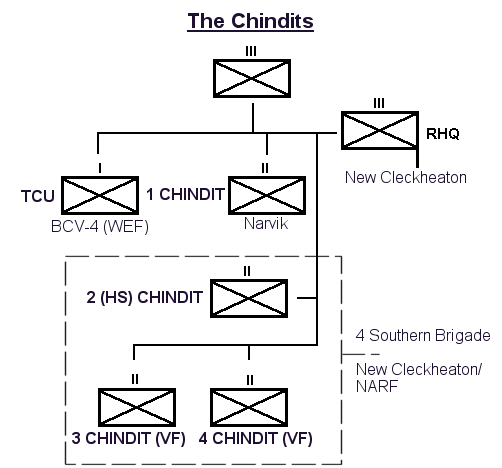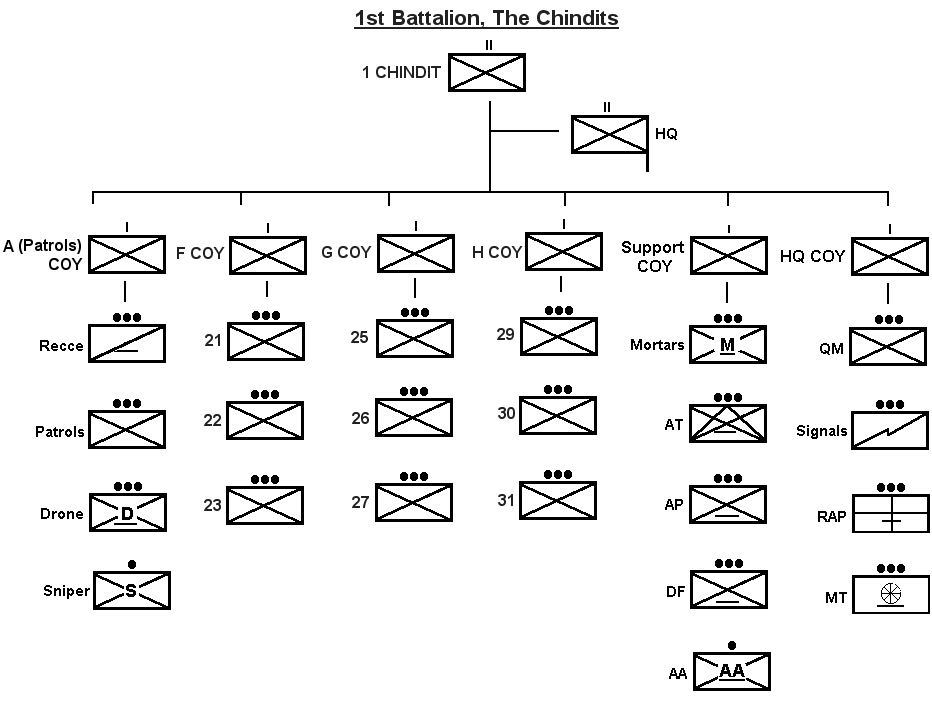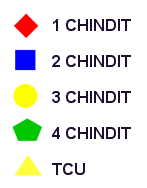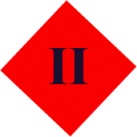Wellon Army: 2300AD
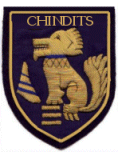
The Chindits of Wellon
Introduction
The Chindits are a Wellon Army infantry regiment comprising one regular, one home service and two volunteer battalions. Recruited from the City of New Cleckheaton and the settlements of the New Albion Rain Forest the regiment is renowned for its jungle fighting skills. Indeed the regiment is a centre of excellence for jungle operations for Wellonese and other forces. However operating in the NARF can sometimes be hazardous to health and Chindits often pay a price for their expertise.
Narrative
The boat glided across the fetid pool, guided by small dips of the paddles. In the bow the lead scout cradled his weapon but fingered the screamer taped to his webbing. In the dark we could hear tentacles grazing the gunwales of the leaky canoe. Behind us a further three boats were sliding along in our wake. Through our HUDs we could seen the spitting treens looped on the branches, watching us pass with luminous eyes.
I'd never been quite so scared and the tension of the other three in the boat suggested I wasn't alone. In our first week in the 'Green', half a lifetime ago now, they'd shown us what the elegantly named Bog Monster could do. They'd floated a fibreglass canoe with a couple of live Jamlans on-board into one of these pools. 'Old Caine', the resident BM, had responded with gusto leaving us in shocked awe and slightly nauseous. Three of the course RTU'd themselves straight away. The trick they later taught us was to use a boat made out of local material which, usually, didn't provoke the Bog Monsters.
Now, in the final week of the course, we were doing a night insertion across one of the most notorious areas of the Green. We were living the Green now, I'd almost forgotten about the outside world and was almost like the skeletal, haunted looking soldiers that were our instructors. They taught us that the jungle was neutral; that we were the aliens here and we would have to adapt. That fighting the jungle was futile and deadly. The weak ones had long gone, only we remained.
Extract from 'Pallida Mors: The Chindits of Wellon'
- 1st Battalion
2nd (HS) Battalion
3rd Battalion (VF)
4th (New Cleckheaton Chindits) Battalion (VF)
Jungle Warfare School
Tracker Combat Unit
In 2195 the Foundation for Practical Knowledge established a permanent scientific enclave on the banks of the Black River in the heart of the New Albion Rain Forest. With no little irony they named this sweltering settlement New Cleckheaton, after a suburb of the West Yorkshire Metroplex in the British Isles. The FPK and the BACS Survey had been running missions into the NARF for over twenty years but this was the first time a long term outpost had been set up.
The New Albion Rain Forest is a vast area of jungle in southern part of New Albion. It area it outmatches any area of jungle remaining on earth and would rival the Amazon at its height. It is a huge expanse of primary jungle crossed by a network of waterways running off the central Heller Mountains. In the early years of the colonisation the NARF was a place of incredible danger to humans. Flora, fauna and disease took its toll. Moving far beyond the rivers was asking for trouble and at times the mortality rates ran to over 50% per annum.
The purpose of New Cleckheaton was to allow the FPK to develop vaccines and countermeasures in relative safety. They would also begin to explore and catalogue the areas around the settlement. The FPK held high hopes about the biological treasure trove that the NARF could become.
At the time it was standard Colonial Office practise for each new settlement of significant size to have its own militia protection. The FPK felt that a traditional militia would be a waste of time, however they did want a force that could protect the settlement from hostile animals and could aid in the exploration of the local area.
They launched a recruitment drive through the British armed forces on Tirane for soldiers with jungle warfare experience who were just about to retire. After a number of interviews and a selection process 30 soldiers and officers were selected. Their commander was a Major Alan Robinson late of the Royal Marines Commandos, an acknowledged jungle warfare specialist and a Fellow of the Royal Geographical Society. The new unit was to be known as the New Cleckheaton Chindits, in recognition of the Anglo-Indian force that fought behind Japanese lines in World War 2.
In the early years of their existence the Chindits acted as paramilitary police force, protection parties, porters and nascent survival experts for the FPK and other foundations who came in. The mortality rate of the Chindits was spectacular, but that bred its own unique esprit de corps amongst the survivors. Tips of jungle lore were passed into the group memory by word of mouth, keeping it alive against the almost inevitable deaths of the most able and daring. The number of ex-British Army jungle warfare experts joining the unit dwindled but the number of soldier in the unit slowly grew. Drawn by a mixture of fame, by now the Chindits had featured in a number of widely shown documentaries, and the distinct challenge.
In 2206 a small contingent of the most experienced troops was seconded from the unit to operate as a Tracker Unit with British and South Albion troops operating in the Southern Archipelago. These jungle trained troops proved an immensely valuable asset, although their standards of soldiering rarely matched their jungle craft. A platoon sized Tracker Unit was constantly on deployment in the Southern Archipelago.
By 2221 the South Albion Territorial Defence Force wanted to expand their military forces raised in the south. At that time only the Livingstone Rangers and the South Albion Gurkha Rifles were regular 'local' forces and the remainder of the units were British Army, Cam Valley battalions or those deployed from the other TDFs. The New Cleckheaton Chindits had already made something of a name for themselves and so the SATDF decided to form an operational battalion from the unit.
Unfortunately the existing size of the NCC and the limited population of even an expanding New Cleckheaton were unable to support this battalion. Instead the SATDF once again recruited ex-British servicemen to fill the ranks of the battalion. Given the reputation of the Chindits the contracts stipulated that the soldiers would not be required to serve in the NARF unless they volunteered. However it was made clear that the battalion would spend the vast majority of its time deployed in the Southern Archipelago.
As a result of this recruitment and new basing of this battalion the unit was renamed simply as The Chindits, losing the New Cleckheaton tag. The field force battalion was designated as the 2nd Battalion, whilst the paramilitary force based at New Cleckheaton and in the slowly spreading NARF settlements became the 1st Battalion.
For over ten years the two battalions had very little to do with each other. The 1st Battalion continued to send small Tracker Units to aid the 2nd Battalion and other units serving in the Archipelago. The 2nd Battalion was based and served solely in the eastern end of the Archipelago and became a very professional and well regarded outfit. However the two units had different recruitment and training practises and only at a senior level was there communication between them.
An early attempt was made to rectify this in 2235, the regiment's 40th anniversary, when the 2nd Battalion was rotated from the Southern Archipelago for a period of jungle training with the 1st Battalion. The 2nd Battalion was very well trained in littoral operations and working in the jungle found in the islands but had no experience in the harsh conditions of the NARF. However this cross training went badly wrong and many 2nd Battalion soldiers suffered very badly from virulent jungle fevers. Although deaths were relatively few almost a third of the battalion were crippled by disease and were forced to retire.
The fall out of this episode was spectacular and nearly broke the regiment. The professional soldiers of the 2nd Battalion were at odds with what they saw as the shambolic amateurism of the 1st Battalion. In turn the 1st Battalion saw their counterparts as little more than mercenaries uninterested in the roots of the regiment or anything but a pay packet. Many soldiers of the 2nd Battalion resigned from the unit and at one stage it looked as if the unit would have to be disbanded.
It took the intervention of Major Howard Warren, one of the few New Cleckheatoners serving with the 2nd Battalion, to bridge the divide. He proposed to rationalise the training of the regiment at a single location and put all recruits through a common syllabus. Individual PF soldiers would be rotated to serve stints in both battalions. Most importantly NARF based jungle training, aided by new vaccinations, would be the backbone of the new regiment. The new policy was implemented in 2237 and slowly began to take effect. Recruiting for the 2nd Battalion was still slow after the 2235 debacle and Warren, now CO of the 1st Battalion proposed the recruitment of ex-members of the South Albion Gurkha Rifles who were now being wound up. This soon solved the problem and many soldiers of Nepali descent still serve with the regiment.
In 2241 the South Albion Territorial Defence Force was dissolved and the new Wellon Defence Force was formed as the Dominion of Wellon came into being with measures of Home Rule from Britain. The Chindits were placed administratively under the newly formed Viscount Khan's Division of Infantry with the other South New Albion infantry units, the Livingstone Rangers and the newly formed Point Sterling Grenadiers. Practically this had little effect as the 2nd Battalion continued to be almost permanently deployed in the Southern Archipelago.
The 1st Battalion was growing steadily along with the population of the NARF region and as new settlements were established on the tributaries of the Black River. The 1st Chindits worked alongside the people and in the absence of the limited local law enforcement presence in the region part-time Chindits were often the only authority for hundreds of kilometres and also provided valuable search and rescue cover. In addition the regiment had just completed a new base on the 20km upstream from New Cleckheaton, Wingate Barracks was accessible only by water or air and gave a secluded area for training.
In 2248 the well established Jungle Cadre training program for Chindit recruits was expanded dramatically, absorbing the South Albion Battle School, and was opened up to soldiers from other regiments. It was soon renamed the Jungle Warfare School and became a separate entity from the Chindits although they still administered it and provided the bulk of the instructors. The JWS proved very popular with units about to deploy in the Southern Archipelago sending junior leaders to it to learn the best doctrine and survival measures. That the NARF was a significantly more dangerous place to soldier than the Archipelago only increased the value of the training.
In late 2266 the 2nd Chindits became a part of the newly formed 3 (Wellon) Light Brigade which was to be the country's specialist jungle warfare formation as well as be capable of conventional operations. The first part of the mission was easily accomplished thanks to almost half a century of near continuous service in the Archipelago. Conventional training was a little more difficult to master as troops and leaders strove to add more flexibility to their operational style and training. However the battalion's professionalism shone through and the change was made without too many problems.
The Chindits were little effected by the creation of the Commonwealth of Wellon in 2277 but the 'New Cardwell' Reforms were more far reaching. By now New Cleckheaton was a thriving city of nearly 1.5 million people and the 1st Chindits was a sprawling administrative mess or detachments and companies scattered across the NARF. The 2nd Chindits remained a single, compact and competent battalion size formation.
To bring the regiment in line with 'New Cardwell' the 2nd Battalion was renumbered as the 1st Battalion. The 1st Battalion was dismembered, expanded and substantially re-organised. The bulk of the training assets, SAR and local Permanent Force personnel were formed into the new 2nd (HS) Battalion based at Wingate Barracks. The numerous part-time detachments scattered across the NARF and in the Black River settlements were combined into a new 3rd Battalion. Finally the units based in New Cleckheaton were formed into a new 4th Battalion which was to once again carry the old New Cleckheaton Chindits name.
This re-organisation, although practical, caused no little discussion amongst the traditionally minded ranks of the regiment. The reforms were still put quickly into practise although the new 1st Battalion still refer to themselves as the '2nd Chindits' - which proves immensely confusing. The regiment was further effected by the need to provide leadership cadres for the newly raised Royal Southern and Coast and Islands Regiments. As the Chindits are a relative small regiment they weren't hit as much as the Rangers and Point Sterling Grenadiers. Those officers and NCOs provided by the Chindits mostly went to the Coast and Islands Regiment whose members wouldn't accept PSG soldiers.
The last few years have seen the 1st Battalion undertake a wider range of activities than ever before, freed from its continuous presence in the Southern Archipelago. It has deployed to Earth on several occasions training alongside Terran jungle specialists. In addition soldiers from the 2nd Battalion have been seconded to jungle warfare schools across human space attempting to widen their knowledge base. In return the British Army has recently established its own school alongside the JWS at Wingate Barracks in order to learn from Wellonese experience.
The Kafer War has seen the readiness of the regiment increase several notches. The 1st Battalion and 3 Light Brigade are on reduced notice for operations on the French Arm. It is rumoured that they may replace 1 Airmobile Brigade on New Africa for operations in the K-Zone. One part of the regiment is already there. A Tracker Combat Unit was raised from across the regiment, predominantly from the 2nd and 3rd Battalions and has deployed to New Africa. The TCU provides small tracker teams to supplement patrols of the multinational V Corps in the K-Zone.
Today the Chindits are a regiment steeped in jungle lore and jungle warfare expertise and are unmatched in their own environment. The 1st Chindits have substantial jungle warfare training but are also a versatile light role battalion in their own right and are respected for their professional outlook and excellence in patrolling.
The modern day Chindits recruit from a variety of sources. The Local PF and VF soldiers of the battalions are, naturally, almost entirely drawn from the Black River Settlements in the NARF or New Cleckheaton. These are mostly second or third generation colonists to the region who entirely identify with the region. Notably a few thousand citizens of Borneo settled in the region as part of a sociological experiment, the traditions of this group have spread to many settlements but they have largely integrated into the developing Black River culture.
Those who are raised outside in the Black River Settlement live very isolated lives and their only links to mainstream Wellonese society are usually through the satellite feeds of the Data Net. People from the NARF can seem somewhat unworldly to those from the outside. They are mostly very private people bound up in the lives of their small communities, the harshness of their lifestyle has given them a very fatalistic outlook. The citizens of New Cleckheaton, for all their city's exotic location live a lifestyle very similar to that of citizens of any Wellonese city.
The 1st Battalion also draws recruits from outside of this region. The most notable of these are the Gurkha communities of the Stirling Peninsular which grew up from retired Gurkha soldiers who served with the South Albion Gurkha Rifles in the first half of the 23rd Century. On the disbandment of the SAGR many found service with the Point Sterling Metropolitan Police and others were recruited into the Chindits. Although less martial than the Pendragon Gurkhas the Stirling Peninsular communities still have a tradition of service with the PSMP and Chindits, whilst some serve with the local regiment. Roughly 30% of the 1st Battalion's manpower comes from this source.
In addition to the Wellonese Nepali community the Chindits draw a number of recruits from across Wellon, although South New Albion predominates. These people usually are drawn by the regiment's reputation and name, they make up less than 5% of the 1st Battalion. Lastly the Chindits have recently tapped a new source of recruits from the Indochinese community in the Bourne River city of Hampton. The first few intakes have proved successful and the regiment hopes to establish a company of the 3rd Battalion in that city to increase its presence.
The regiment has had a constant problem with keeping its recruitment up to strength. A process hampered by higher than average rates of disease related attrition of its soldiers. However strenuous measures are taken, including rumoured fraud over numbers in the remote 3 CHINDIT detachments, to maintain the strength of the unit. The regiment has a greater than average proportion of female soldiers in ranks.
Chindit training follows the standard pattern for Wellon infantry regiments. Phase 1 Training is conducted for most recruits at Wingate Barracks near New Cleckheaton. Those who have enlisted outside of the NARF area report to a local centre for Phase 1. In the case of the Wello-Nepalis it is usually Slim Barracks on the outskirts of Point Sterling.
Phase 2 Training is conducted at the Viscount Khan Infantry Training Centre at Bartown at the base of the Sterling Peninsular. The fall out rate for Chindit recruits at Bartown is significantly higher than for those of the other regiments. This is usually prescribed to the culture shock on recruits from the Black River Settlements. However fingers have also been pointed at the standard of training at Wingate Barracks and this is being looked at.
Once the recruit has passed Phase 1 they are posted first to the 2nd Battalion. Here they are then all placed on the Jungle Trooper Course at JWS which they must successfully pass. That every recruit, PF or VF must take this course is a primary factor in the maintenance of the unit's integrity and has been since the late 2230's. The Para Battle Cadre must also be passed by soldiers before being posted in to the 1st Battalion. Most soldiers will return to JWS to take other courses as they progress in their careers.
The 2nd Battalion also runs leadership training for NCOs and potential officers prior to their attendance at RMANC. The Chindits draw most of their officers from the ranks of the battalions and most have proven their abilities before being put forward for promotion.
The Chindits are organised with one PF battalion, one HS battalion and two VF battalions. The Chindits' RHQ is located in Civic Square with a small regimental museum in the centre of New Cleckheaton.
